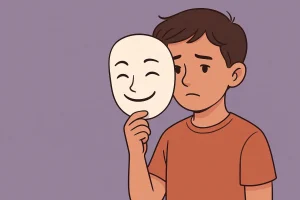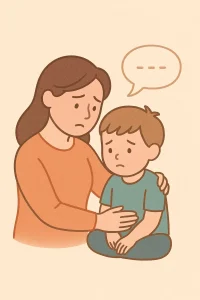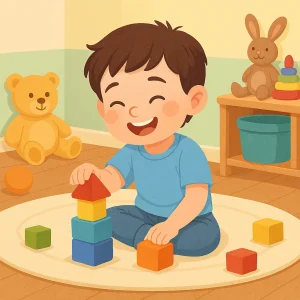What are the therapies offered to Autistic kids? | Therapies of Autism
By Rajini D
Last Updated: November 27, 2021
Autism Spectrum Disorder (ASD) is as diverse as the spectrum it represents, encompassing a range of conditions characterized by challenges in social skills, repetitive behaviors, speech, and nonverbal communication, along with unique strengths and differences. The nature of ASD means that no two individuals with autism are alike; each has their own set of challenges and capabilities, making personalized therapy plans not just beneficial but essential for effective treatment and support.
This article aims to explore the wide range of therapies available for individuals with autism. From conventional approaches like Applied Behavior Analysis (ABA) and Speech Therapy to more innovative methods such as Equestrian Therapy and Music Therapy, our objective is to provide a comprehensive overview that can guide families in making informed decisions about the care and support for their loved ones with ASD.
Understanding ASD and Its Impact
Autism Spectrum Disorder (ASD) is a complex developmental condition that affects individuals differently, with a range of symptoms that can include challenges in social interaction, communication, and behavior. These symptoms can vary widely from person to person, highlighting the spectrum nature of ASD. Some individuals may face significant difficulties in verbal and non-verbal communication, while others may experience challenges in understanding social cues or exhibit repetitive behaviors. This variability underscores the critical need for tailored therapeutic approaches that address the specific needs of each individual with ASD.
Also Read: Early Identification/ Warning Signs in child development

There are many therapies offered to the Autistic people to cater to their needs. The therapies such as ABA, Speech therapy, occupational therapy, special education, social skills therapy, and psychological therapy are the major ones.
Know more about Navigating Online Speech Therapy for Non-Verbal Children: A Guide for Parents and Educators
Applied Behavior Analysis (ABA)
Applied Behavior Analysis (ABA) is a therapy based on the science of learning and behavior. The goal of ABA is to improve social skills, communication, and behavior through a system of positive reinforcement. By breaking down desired skills into manageable steps, ABA therapists can systematically teach these skills and reward progress, thereby encouraging their use in everyday situations.
ABA therapy is highly personalized, taking into account the individual needs, preferences, and interests of each person. Through one-on-one sessions, group activities, or even in-home programs, ABA can significantly improve behaviors that are essential for daily living and integration into community settings. Its flexibility allows it to be tailored to meet the unique challenges faced by individuals with ASD, making it one of the most effective approaches in autism therapy.
Learn more about Speech and Language Therapy Difficulties faced by Autistic Children
Speech and Language Therapy
Communication challenges are a hallmark of autism, affecting both the ability to express thoughts and feelings and to understand others. Speech and Language Therapy addresses these challenges, aiming to enhance both understanding and expression in individuals with ASD. This therapy goes beyond mere speech improvement to include non-verbal communication skills, such as gestures, sign language, and the use of technology aids.
Speech therapists work closely with individuals to identify specific communication hurdles and tailor interventions accordingly. Whether it’s improving articulation, building vocabulary, or fostering social communication skills like taking turns in conversation, Speech and Language Therapy can open new avenues for interaction. For many with autism, these improvements in communication are key to forming relationships and participating more fully in the world around them.
Understanding the speech chain is essential for grasping how speech therapy aids children with ASD in their communication skills.
Occupational Therapy
Occupational Therapy (OT) plays a pivotal role in aiding individuals with ASD to master daily living skills. This therapy focuses on improving sensory integration and fine motor skills, essential components for navigating the complexities of everyday life. OT practitioners work with children and adults to enhance their ability to perform tasks ranging from basic self-care to more complex activities required in school and beyond.
Through personalized activities, Occupational Therapists address sensory processing issues that many individuals with ASD experience. By helping them manage sensitivities or sensory seeking behaviors, OT facilitates a better interaction with the environment. Additionally, fine motor skills development is crucial, assisting in everything from writing to dressing, thereby promoting independence and confidence.

Occupational therapy facilitates mastering daily living skills, and parents can support their child’s development with home-based activities
Cognitive Behavioral Therapy (CBT)
Cognitive Behavioral Therapy (CBT) offers a powerful tool for managing anxiety and improving emotional regulation, common challenges for those with ASD. CBT works by helping individuals understand the connections between their thoughts, feelings, and behaviors. Through this understanding, they can learn strategies to manage distressing thoughts and emotions, leading to more positive outcomes in their daily interactions.
CBT is particularly effective in providing coping mechanisms for anxiety, allowing individuals with ASD to navigate social situations and changes in routine with greater ease. The structured nature of CBT, with its focus on problem-solving and action, makes it an appealing option for many with ASD, offering them a pathway to greater emotional resilience.
CBT can be effective in managing anxiety, including test anxiety, which is common among children with ASD.

Social skills Therapy
For individuals with ASD, developing interactive skills is crucial for better social integration. Social Skills Training encompasses a range of strategies designed to enhance communication, understanding of social cues, and the ability to form and maintain relationships. Through role-playing, group sessions, and one-on-one coaching, this training addresses the nuances of social interactions that might not come naturally to those with ASD.
This training goes beyond mere conversation skills, encompassing the understanding of non-verbal communication, empathy, and how to navigate the give-and-take of relationships. For many with ASD, Social Skills Training opens up new avenues for connecting with others, enriching their social experiences, and fostering a sense of belonging.
Therapy Comparison Chart
| Therapy Type | Target Symptoms | Age Group | Expected Outcomes |
|---|---|---|---|
| Applied Behavior Analysis (ABA) | Communication difficulties, behavioral challenges | Toddlers to adults | Improved communication, reduced behavioral issues |
| Speech and Language Therapy | Speech delays, communication challenges | All ages | Enhanced expressive and receptive language skills |
| Occupational Therapy | Sensory processing issues, daily living skills | All ages | Better sensory integration, improved motor skills |
| Cognitive Behavioral Therapy (CBT) | Anxiety, emotional regulation difficulties | School-aged children to adults | Improved emotional regulation, reduced anxiety |
| Social Skills Training | Difficulty with social interactions | All ages, best for school-aged children | Enhanced social interaction and communication skills |
| Early Intervention Programs | Broad developmental delays | Infants and toddlers | Improved developmental outcomes across various domains |
| Educational and School-based Therapies | Academic and social development challenges | School-aged children | Tailored learning strategies, enhanced academic and social skills |
| Music Therapy | Communication and emotional expression difficulties | All ages | Increased emotional expression, improved social skills |
| Equestrian Therapy | Social communication challenges, motor skills | All ages, often children | Improved motor skills, enhanced social communication |
| Play Therapy | Social interaction difficulties, emotional regulation | Primarily children | Improved social skills, better emotional understanding |
Early Intervention Programs
The cornerstone of effective ASD management lies in early intervention. Initiating therapy at a young age can significantly influence the long-term development of children with ASD, enhancing their ability to communicate, interact socially, and learn new skills. The benefits of early intervention are well-documented, showcasing improvements in cognitive abilities, behavioral challenges, and overall adaptive skills. By addressing developmental delays at the earliest possible stage, these programs set a foundation for success in various aspects of life, from academic achievement to personal independence.

Educational and School-based Therapies
Personalized educational plans are integral to supporting the academic and social development of children with ASD. Tailored to meet each child’s unique needs, these plans often include specialized instruction methods, adaptations in the classroom environment, and the incorporation of specific goals aimed at enhancing learning outcomes. Collaboration among educators, therapists, and families ensures that these plans are effectively implemented, providing a supportive educational journey that recognizes and fosters the individual strengths and potential of each child.
Early Intervention Timeline
| Age Range | Developmental Milestones | Recommended Therapies |
|---|---|---|
| 0-6 Months | Smiling, eye-contact, cooing, interest in faces | Early screening, Family education and support |
| 6-12 Months | Babbling, reaching for objects, sitting without support | Physical therapy for motor skills, Early speech-language evaluation |
| 12-18 Months | Walking, saying first words, pointing to objects | Speech therapy for language development, Occupational therapy for fine motor skills |
| 18-24 Months | Playing simple pretend, using 2-word phrases | ABA for social skills and behavior, Continued speech therapy |
| 2-3 Years | Following instructions, showing interest in peers | Social skills groups, Continued ABA and occupational therapy |
| 3-5 Years | Engaging in cooperative play, more complex sentences | Preschool programs with special education services, Speech and language therapy |
| 5 Years and Above | School readiness skills, complex conversation | School-based therapies, Cognitive Behavioral Therapy (CBT) for emotional regulation, Social skills training |
Other Therapies
In addition to the core therapies, a range of supplementary interventions plays a vital role in a comprehensive care plan for individuals with ASD. These include:
Music Therapy: Through engagement with music, individuals with ASD can experience improvements in social communication, emotional expression, and sensory processing. The structured yet flexible nature of music therapy allows for personalized sessions that cater to the interests and therapeutic needs of each person.
Equestrian Therapy: Also known as therapeutic horseback riding, equestrian therapy offers a unique opportunity for physical and emotional growth. The bond formed with the horse can enhance social skills, reduce anxiety, and improve motor coordination and balance.
Play Therapy: Focused on leveraging the natural language of play, this therapy helps children with ASD develop social skills, emotional regulation, and communication abilities. Play therapy provides a safe and supportive environment for children to express themselves and learn in a manner that is both effective and enjoyable.
Steps to Choosing the Right Therapy
Assess Needs and Goals: Begin by evaluating your child’s specific challenges and strengths. Consider areas such as communication, social skills, sensory processing, and daily living skills. Identifying these will help pinpoint which therapies might be most beneficial.
Consider the Child’s Interests: Therapy is often most effective when it engages the child’s interests. For example, if your child loves music, incorporating music therapy might not only be enjoyable for them but also more effective in achieving therapeutic goals.
Evaluate the Severity of Symptoms: The intensity and type of therapy can depend on how ASD affects your child. Children with more severe symptoms might benefit from intensive therapies, while those with milder symptoms may thrive with less intensive support.
Research Therapy Options: With a clear understanding of your child’s needs, research the various therapies available. This can include Applied Behavior Analysis (ABA), Speech and Language Therapy, Occupational Therapy, and others mentioned throughout this article.
Consult Healthcare Professionals: Seeking advice from healthcare professionals, including pediatricians, psychologists, and specialized therapists, can provide valuable insights into the most suitable therapies for your child. They can assess your child’s needs comprehensively and recommend evidence-based interventions.
Visit Therapy Centers: If possible, visit therapy centers or speak with therapists to get a feel for the environment and the approach they take. It’s important that both you and your child feel comfortable and supported.
Know more about to How to find the right Autism therapy center for my child?
Consider Logistical Factors: Accessibility, schedule, and insurance coverage are practical considerations that can influence therapy choices. Ensure the therapy fits within your family’s lifestyle to maintain consistency and support long-term commitment.
Trial and Evaluate: Therapy is often a process of trial and feedback. Starting a therapy doesn’t mean you’re committed to it indefinitely. Assess progress regularly and don’t hesitate to make adjustments as needed.
Tips for Active Involvement in Your Child’s Therapy
Understand the Therapies: Take the time to learn about the therapies your child is receiving. Understanding the goals and methods of therapies such as Applied Behavior Analysis (ABA), Speech and Language Therapy, or Occupational Therapy can help you reinforce these strategies at home.
Communicate Regularly with Therapists: Establish a strong, open line of communication with your child’s therapists. Regular updates about your child’s progress and challenges allow for adjustments in therapy and provide you with insights on how to support your child effectively.
Participate in Sessions: When possible, participate in therapy sessions or observe them. This can give you a firsthand understanding of the techniques used and how you can apply them in daily interactions with your child.
Reinforce Strategies at Home: Implement the strategies and approaches used in therapy within your home environment. Consistency is key to reinforcing new skills and behaviors. Ask therapists for specific activities or exercises you can do at home to support your child’s learning and development.
Create a Supportive Home Environment: Tailor your home environment to support the goals of your child’s therapies. This might include creating structured routines, using visual schedules, or setting up a sensory-friendly space.
Educate Siblings and Family Members: Educate siblings and other family members about ASD and the importance of the therapies your child is receiving. Encouraging positive interactions and understanding among siblings can provide additional support and reinforcement.
Celebrate Progress: Recognize and celebrate your child’s progress, no matter how small. Positive reinforcement can boost your child’s self-esteem and motivation.
Seek Support for Yourself: Supporting a child with ASD can be challenging. Seek support for yourself through parent support groups, counseling, or connecting with other families navigating similar journeys. Wellness Hub offers resources and connections to support networks that can be invaluable.
Stay Informed: The field of ASD therapies is always evolving. Stay informed about the latest research, therapies, and strategies by utilizing resources such as Wellness Hub. Continuous learning can help you make informed decisions about your child’s care.
Advocate for Your Child: Become your child’s biggest advocate in all settings, including educational environments. Understanding your child’s rights and the services available can help ensure they receive the support they need to thrive.
Explore more on Understanding & Parenting an Autistic Child: Guide & Tips
Conclusion:
Navigating the journey of Autism Spectrum Disorder (ASD) requires a roadmap tailored to each individual’s unique needs and challenges. This article has underscored the importance of personalized therapy plans that are as diverse and dynamic as the spectrum itself. From Applied Behavior Analysis (ABA) to Speech and Language Therapy, Occupational Therapy, and beyond, the array of interventions available offers hope and pathways to improvement and independence for individuals with ASD. Emphasizing early intervention and the significance of selecting the right therapies based on the child’s needs, interests, and the severity of symptoms, we’ve explored how engaging with your child’s care and working closely with therapists can reinforce strategies at home, fostering an environment conducive to growth and learning.
At Wellness Hub, we are committed to supporting families on this journey, providing access to resources, professionals, and guidance that can light the way forward. Our platform serves as a conduit to a community of experts and a wealth of information, ensuring that no family navigates this path alone. We encourage our readers to reach out for support, to explore the therapies that resonate with their loved one’s needs, and to remember that every step taken is a step towards unlocking their full potential. With Wellness Hub by your side, the journey through ASD therapy can be one of discovery, hope, and empowerment, leading to a future where every individual with ASD can thrive.
Frequently Asked Questions:
1. What is Autism Spectrum Disorder (ASD)?
Unsure about Autism Spectrum Disorder (ASD)? We’ve got you covered! ASD is a developmental disorder impacting social skills, communication, speech, and nonverbal cues. Importantly, ASD affects individuals uniquely, with varying intensities. Learn more about the range of experiences within the autism spectrum.
2. Why is Early Intervention Crucial for Autism?
⏰ Time is of the essence for children with ASD. Early intervention unlocks significant improvements in their long-term well-being. By harnessing the brain’s plasticity at a young age, therapies empower children to acquire new skills and adapt behaviors effectively. Discover the benefits of early intervention for ASD.
3. Key Therapies for Autism: A Comprehensive Guide.
Seeking effective therapies for autism? Look no further! Explore renowned approaches like Applied Behavior Analysis (ABA), Speech & Language Therapy, Occupational Therapy, Cognitive Behavioral Therapy (CBT), and Social Skills Training. Each therapy targets specific needs, addressing communication challenges, social interactions, and behavioral concerns. Delve deeper into each therapy’s unique strengths.
4. How Does Applied Behavior Analysis (ABA) Empower Children with Autism?
Witness the transformative power of ABA for children with autism. This therapy leverages positive reinforcement to enhance social, communication, and learning skills. By breaking down complex behaviors into manageable steps, ABA offers a structured path to development and positive behavior change. Explore the science behind ABA’s success.
5. Can Speech Therapy Bridge the Communication Gap for Children with Autism?
Unlock the potential of speech therapy for children with autism. This therapy goes beyond spoken language, addressing both verbal and nonverbal communication. From articulation and language development to alternative communication methods for non-verbal individuals, speech therapy empowers children to connect and express themselves. Learn how speech therapy can make a difference.
6. Occupational Therapy: Equipping Individuals with Autism for Daily Life
Independence and daily living skills are within reach for individuals with autism. Occupational therapy plays a pivotal role, addressing sensory integration, fine motor skills, and self-care routines. Tailored to each individual’s needs, this therapy empowers them to navigate daily life with confidence. Discover the impact of occupational therapy in autism treatment.
7. Is Cognitive Behavioral Therapy (CBT) a Beacon of Hope for Individuals with Autism?
Navigate anxiety and emotional challenges with the power of CBT. This therapy empowers individuals with autism to identify and change negative thought patterns and behaviors, equipping them with coping mechanisms for various situations. Learn how CBT can enhance emotional well-being in autism.
8. Empowering Parents: Supporting Your Child’s Therapy Journey at Home
Parents play a vital role in their child’s therapy journey. Reinforcing learned strategies and skills at home is key. Create a supportive environment, practice consistently, and maintain open communication with therapists. Discover tips and strategies to empower your child’s progress.
9. Unveiling a World of Support: Navigating Autism Therapies with Wellness Hub
Knowledge is power, especially when navigating the complexities of ASD therapies. Wellness Hub is your one-stop platform, offering a comprehensive guide on various therapies, inspirational success stories, and expert guidance. Connect with specialized therapists and empower yourself with informed decisions. Visit Wellness Hub today!
10. Wellness Hub: Your Guiding Light on the Autism Therapy Journey
We at Wellness Hub stand committed to supporting families and individuals navigating the complexities of ASD therapies. Our comprehensive online platform empowers you with a wealth of resources, including articles on various therapies, professional guidance, and connections to specialized therapists. Our mission is to equip you with knowledge, enabling you to make informed choices and chart a personalized therapy path for your loved one. Join us on this journey!
About the Author:
Rajini, Speech-Language Pathologist:
Rajini is a dedicated Speech-Language Pathologist with a focus on developmental speech and language disorders in children and rehabilitation in adults. With a passion for helping each individual find their voice, Rajini brings a wealth of experience and a heartfelt approach to therapy. At Wellness Hub, she’s part of a team that values innovation, compassion, and results-driven practices.
Book your Free Consultation Today
Parent/Caregiver Info:
Client’s Details:
* Error Message








